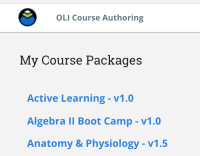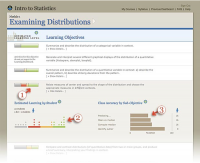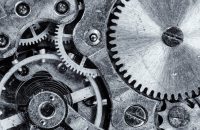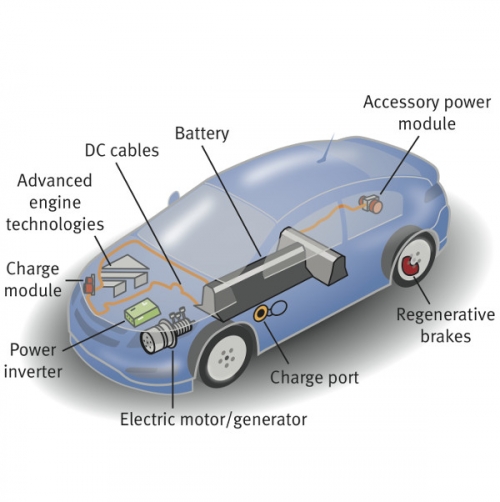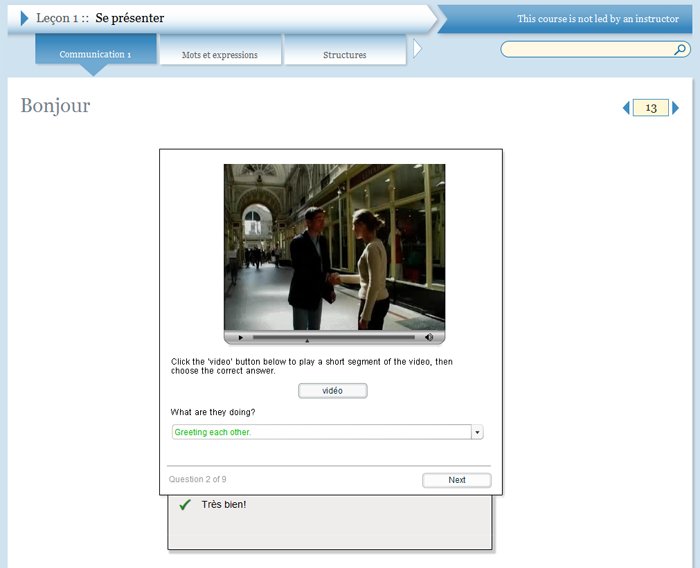Approach the study of the body in an organized way to fully comprehend how all of the intricate functions and systems of the human body work together. Connect what you learn about anatomy and physiology to what you already know about your own body.
Anatomy & Physiology I & II
$25
- Description
- What students will learn
- Learning objectives by module
- Course assessments, activities, and outline
- Other course details
- System requirements
- Included instructor tools
Description
You probably have a general understanding of how your body works. But do you fully comprehend how all of the intricate functions and systems of the human body work together to keep you healthy? This course will provide that insight. By approaching the study of the body in an organized way, you will be able to connect what you learn about anatomy and physiology to what you already know about your own body.
By taking this course, you will begin to think and speak in the language of the domain while integrating the knowledge you gain about anatomy to support explanations of physiological phenomenon. The course focuses on a few themes that, when taken together, provide a full view of what the human body is capable of and of the exciting processes going on inside of it. The themes are:
- Structure and function of the body, and the connection between the two.
- Homeostasis, the body’s natural tendency to maintain a stable internal environment.
- Levels of Organization, the major levels of organization in the human organism from the chemical and cellular levels to the tissues, organs and organ systems.
- Integration of Systems, concerning which systems are subsets of larger systems, and how they function together in harmony and conflict.
Developed with best practices in applied learning theory, this course offers an active learning experience for any student in the form of pre-tests, ample practice opportunities, 3D interactive images, walkthrough videos, and other special tools and applications that will increase your comprehension of anatomy and physiology. Ultimately, your understanding of the material offered in this course will provide you with a solid foundation to explore careers in the health and fitness industries.
In-Depth Description
In addition to the course themes of: Structure and Function, Homeostasis, Levels of Organization, and Integration of Systems, this course has the following units:
- Introduction
- Levels of Organization
- Homeostasis
- Skeletal System
- Muscular System
- Integumentary System
- Endocrine System (includes Reproduction)
- Digestion (includes Metabolism & Nutrition)
- Cardiovascular System
- Respiratory System
- Urinary System
- Lymphatic System and Immunity
- Review and Synthesis (with a disease and diagnosis focus)
What students will learn
By the end of this course, students will learn or be able to:
- Comprehend how all of the intricate functions and systems of the human body work together to keep you healthy.
- Approach the study of the body in an organized way.
- Connect what you learn about anatomy and physiology to what you already know about your own body.
- Begin to think and speak in the language of the domain while integrating the knowledge you gain about anatomy to support explanations of physiological phenomenon.
- Understand a full view of what the human body is capable of and of the exciting processes going on inside of it.
Learning objectives by module
Unit 1: Welcome to CC
- Module 1: How to Succeed in Anatomy and Physiology
- Discover and execute the metacognitive cycle as you move through CC-OLI Anatomy and Physiology.
Unit 2: Introduction to Anatomy and Physiology
- Module 2: Anatomy and Physiology Introduction
- Classify individual body system functions based on their contribution to vital human functions.
- Describe how the “Big Ideas” in Anatomy and Physiology to develop a context that facilitates deep understanding of key concepts, connections and interdependencies.
- Use a thematic framework to make sense of the different components of anatomy and physiology.
- Use body planes and directional orientation to describe the locations of body structures.
- Module 3: Introduction of Systems
- Describe the cardiovascular system: list the major organs and structures, describe the major functions, and use anatomical planes and directional terms to identify organs and their relationships to each other.
- Describe the digestive system: list the major organs and structures, describe the major functions, and use anatomical planes and directional terms to identify organs and their relationships to each other.
- Describe the endocrine system: list the major organs and structures, describe the major functions, and use anatomical planes and directional terms to identify organs and their relationships to each other.
- Describe the integumentary system: list the major organs and structures, describe the major functions, and use anatomical planes and directional terms to identify organs and their relationships to each other.
- Describe the lymphatic system: list the major organs and structures, describe the major functions, and use anatomical planes and directional terms to identify organs and their relationships to each other.
- Describe the muscular system: list the major organs and structures, describe the major functions, and use anatomical planes and directional terms to identify organs and their relationships to each other.
- Describe the nervous system: list the major organs and structures, describe the major functions, and use anatomical planes and directional terms to identify organs and their relationships to each other.
- Describe the respiratory system: list the major organs and structures, describe the major functions, and use anatomical planes and directional terms to identify organs and their relationships to each other.
- Describe the skeletal system: list the major organs and structures, describe the major functions, and use anatomical planes and directional terms to identify organs and their relationships to each other.
- Describe the urinary system: list the major organs and structures, describe the major functions, and use anatomical planes and directional terms to identify organs and their relationships to each other.
- List the organ systems of the human body, and identify the main organs for each.
Unit 3: Levels of Organization
- Module 4: Levels of Organization Introduction
- Describe, in order from simplest tomost complex, the major levels of organization in the human organism.
- Module 5: Chemistry
- Define an acid and a base and locateeach on a pH scale.
- Define atoms, molecules andmacromolecules and list their hierarchical assembly.
- Describe how amphipathicstructures of lipids lead to compartmentalization. Describe how lipids are distributed in acell membrane.
- Describe the basic structure ofamino acids.
- Describe the four levels ofprotein structure and discuss the importance of protein structure in function.
- Describe the structure and differenttypes of carbohydrates.
- Describe the structure of DNA andits role in protein synthesis.
- Discuss how atoms combine via ionic and covalent bonds to form molecules.
- Discuss how control of DNAexpression is related to cell properties.
- Discuss the physiologicallyimportant properties of water and how these properties are functions of the molecularstructure.
- Identify biologically relevantatoms and use atomic information to calculate molecular weight.
- List and describedifferent protein functions within different cell types.
- List and explain the threemajor functions of carbohydrates.
- List the four essentialmacromolecules in physiology. Explain how properties of the substructure relate to thefunction of the macromolecule.
- Module 6: The Cell
- Define and describe the functions of major cellularorganelles in human cells.
- Define filtration andprovide examples of molecules that move across membranes via filtration.
- Define the term cell and describe how cellstructures relate to function. Identify and briefly describe the three main parts of acell.
- Describe endocytosis andexocytosis as a means of moving materials across the membrane.
- Describe the componenets and structure of a cellmembrane.
- Describe the environment in which diffusion will occur. Provide examples ofsubstances that move by simple diffusion and facilitated diffusion
- Describe the process of activetransport, its energy requirements, and list examples of substances that useit.
- Describe the process ofosmosis and explain the effects of hypertonic, isotonic, and hypotonic conditions on cellsand water shifts in the human body.
- Identify and describe the stagesof somatic cell division including interphase and mitosis. Describe how cell number ismaintained and the processes associated with cell death: apoptosis and necrosis.
- Module 7: Higher Order Structures
- Define organ. Discuss the organ levelwithin the larger hierarchy of human physiology.
- Define tissue. List the four majortissue types and organ systems associated with each.
- Discuss how the organ systems worktogether in the whole body and how the body interacts with the environment to impactphysiology.
Unit 4: Homeostasis
- Module 10: Integration of Systems
- Explain how different organ systems relate to one another to maintain homeostasis.
- Module 8: Homeostasis and Feedback Loops
- Compare and contrast positive and negative feedback in terms of the relationship between stimulus and response.
- Define homeostasis and describe the multiple levels of homeostatic maintenance in physiology.
- List the components of a feedback loop and explain the function of each.
- Provide an example of a negative feedback loop. Describe the specific structures (organs, cells or molecules) included in the feedback loop.
- Provide an example of a positive feedback loop. Describe the specific structures (organs, cells or molecules) included in the feedback loop.
- Module 9: Homeostatic Maintenance
- Describe how abnormalities in homeostatic feedback loops lead to disease states.
- Predict the types of problems that would occur if homeostasis could not be maintained.
Unit 5: Skeletal System
- Module 11: Skeletal System Introduction
- Explore examples of homeostasis in the skeletal system.
- Identify and discuss components of the skeletalsystem.
- Review common facts and myths about the skeletalsystem.
- Module 12: Skeletal Structures and Functions
- Compare and contrast Compact(cortical) bone with Spongy (cancellous) bone.
- Compare and contrast the bones andthe functions of the Axial and Appendicular divisions of the skeleton.
- Describe the classificationof bone based on shape.
- Describe the functionalclassification of articulations, based on degree of movement allowed—synarthrotic,amphiarthrotic, and diarthrotic—and provide examples of each type.
- Describe the three maincomponents of a long bone.
- Identify and label the bones of theaxial skeletal system.
- Identify and label the bones ofthe appendicular skeleton.
- Integrate the functions of thedifferent skeletal system components to the system functions.
- Module 13: Skeletal Levels of Organization
- Compare intramembranous andendochondral (intracartilaginous) bone formation.
- Describe the effects of afracture and the most common types of fractures.
- Describe the functions of theinorganic extracellular matrix components in osseous (bone) tissue.
- Describe the functions of theorganic extracellular matrix components in osseous (bone) tissue.
- Describe the mechanics of bonerepair and aging.
- Integrate the levels of organizationin the skeletal system and their functional interconnections.
- List the cell types andextracellular matrix components in the osseous (bone) and describe theirfunction.
- Visually identify microscopicand macroscopic bone structures.
- Module 14: Skeletal Homeostasis
- Describe the cellular andextracellular matrix reorganization that occurs in response to stress (force) onbones.
- Describe the passive and activeresponses that occur in cartilage when stress (force) on the tissue changes.
- Describe two disorders of the skeletal system that can result from calcium deficiency.
- Explain how the skeletal systemand endocrine system interact for calcium homeostasis.
- Module 15: Skeletal Integration of Systems
- Discuss ways in which other bodysystems integrate with the skeletal system.
Unit 6: Muscular System
- Module 16: Muscular System Introduction
- Explore examples of homeostasis in the muscular system.
- Identify and discuss components of the muscular system.
- Review common facts and myths about the muscular system.
- Module 17: Muscular Structures and Functions
- Define the terms muscle tone, hypotonia and hypertonia.
- Define the terms prime mover (or agonist), antagonist, synergist and fixator and provide an example of each.
- Define the terms: aponeuroses, tendons, bursae.
- Describe different fiber organization (parallel, convergent, pinnate, sphincter) and how the organization is related to functions.
- Describe the composition of the connective tissue layer that surrounds each cell, fascicle, muscle and group of muscles.
- Describe the difference between isometric and isotonic contractions of muscle.
- Differentiate among the three classes of levers in terms of the relative position of fulcrum, effort and load, as well as in terms of the relative power and range of motion.
- Module 18: Muscular Levels of Organization
- Compare and contrast the structure, location in the body and function of skeletal muscle, cardiac muscle and smooth muscle.
- Define and describe the functions of major cellularorganelles in human cells.
- Define the term cell and describe how cellstructures relate to function. Identify and briefly describe the three main parts of acell.
- Describe how the parallel organization of a sarcomere relates to force generation; predict what effect changes in filament overlap would have on muscle function.
- Describe myoblast fusion to generate multinucleated skeletal muscle cells and tissue structure.
- Describe the anatomy of the neuromuscular junction.
- Describe the difference between tetanus and treppe.
- Describe the difference in distribution of cell/fiber types in different specific body muscles.
- Describe the different structural levels of skeletal muscle organization.
- Describe the interaction of actin and myosin in force generation. Identify which cofactors (ions and proteins) regulate actin-myosin force generation.
- Describe the mechanisms that muscle fibers use to generate ATP for muscle contraction.
- Describe the process of activetransport, its energy requirements, and list examples of substances that useit.
- Describe the sequence of events involved in the contraction cycle of skeletal muscle.
- Describe the specialized structures of muscle cells.
- Explain how an electrical signal from the nervous system is communicated to muscle cells.
- Explain how the cellular organization of fused skeletal muscle cells allows muscle tissue to contract properly.
- Explain the effects of summation and recruitment on muscle contraction.
- Explain the three phases twitch undergoes as viewed on a myogram.
- Identify muscle tissue as being a mixture of SO, FG, and FO cells/fibers.
- Identify skeletal, cardiac and smooth muscle cells by anatomical features.
- List the anatomical and metabolic characteristics of fast, slow, and intermediate muscle fibers.
- List the sources of energy used in muscle contraction.
- Module 19: Muscular Homeostasis
- Describe how an improperly functioning skeletal muscular system would affect other systems.
- Describe several factors that can affect the endurance of muscles.
- Explain the role of the muscular system in maintaining temperature homeostasis.
- Provide examples of factors that can affect muscle size.
- Module 20: Muscular Integration of Systems
- Describe how an improperly functioning skeletal muscular system would affect other systems.
- Describe how muscle tissue within the cardiovascular system contributes to proper function.
- Describe how muscle tissue within the digestive system contributes to proper function.
Unit 7: Integumentary System
- Module 21: Integumentary System Introduction
- Explore common facts and myths about the integumentarysystem.
- Explore examples of homeostasis in the integumentary system.
- Identify and discuss components of the integumentarysystem.
- Module 22: Integumentary Structures and Functions
- Describe the main function of each layer of the integumentary system.
- Module 23: Integumentary Levels of Organization
- Contrast the structure and function ofeccrine(merocrine)glands, apocrine glands, and sebaceous glands.
- Define and describe the functions of major cellularorganelles in human cells.
- Describe four functions of hair.
- Describe how the distribution of adipose tissue differs based on gender,age, diet and exercise.
- Describe how the molecular assembly of keratinsprovidesstrength to integumentary tissues.
- Describe inorder,from simplest to most complex, the major levels of organization of the integumentary system.
- Describe sunscreen and UVA and UVBradiation.
- Describe the complementaryfunctioningof the cells of the epidermis.
- Describe the differences between the three categories of skin cancer.
- Describe the four levels ofprotein structure and discuss the importance of protein structure in function.
- Describe the function of melanin and discuss the consequences of reduced melanin.
- Describe the functions of melanocytes.
- Describe the functions ofthe epidermis.
- Describe the production and function of vitamin D and discuss the consequences of reduced vitamin D.
- Describe the role of melanocytes inproducing skin pigmentation and also protecting mitotic cells inthestratum basale from UV damage.
- Describe the structure and function offingernailsand toenails.
- Describe the structure and roles of the accessory structures of the integumentary system.
- Describe the structure of hair andof ahair follicle.
- Describe the three stages of hair growth.
- Describe the two different layers of the dermis.
- Explain common causes of hair loss.
- Explain how wrinkles and stretch marks are related to the collagen and elastin fibers in the dermis.
- Explain why the histology of the dermisiswell-suitedfor its functions.
- Explain why the histology of theepidermis iswell-suitedfor its functions.
- Explain why the histology of thesubcutaneous layer iswell-suitedfor its functions.
- Identify and describe the layers ofthe epidermis, indicating which are found in thin skin and which are found in thickskin.
- Identify and describe the subcutaneoustissue, including the tissue types making up subcutaneous tissue.
- Identify the cells of the epidermis, dermis and hypodermis.
- Identify the cells of theepidermis based on their location and anatomic structure (stem cells ofthestratum basale, keratinocytes, melanocytes, Langerhans cells, Merkelcells).
- Identify the tissue type makingup the epidermis.
- List and describedifferent protein functions within different cell types.
- Module 24: Integumentary System Homeostasis
- Compare homeostasis of cell numberand mitotic rate in the epidermis with pathologicalconditions,including psoriasis and skin cancer.
- Comparethermoregulationby the integumentary systemas it pertainstosubcutaneous fat, hair,sweatand blood flow.
- Describe different sensory receptors located in the integumentary system.
- Describe how a medical professional can use changes in the appearance of the skin to predict certain medical conditions.
- Describe the cells involved in repairing damaged skin.
- Describe the effect ofscarringon regeneration of accessory structures.
- Explain changes in the integumentary system that occur because of puberty and advanced age.
- Predict issues related to loss ofskin in burn victims forfirst-,second-andthird-degreeburns.
Unit 8: Endocrine System
- Module 25: Endocrine Structures and Functions
- Define homeostasis and describe the multiple levels of homeostatic maintenance in physiology.
- Describe the major functions of the endocrinesystem.
- Identify major diseases associated with the endocrine systemand their causes.
- Module 26: Endocrine Levels of Organization
- Compare the hormones secreted from organs with secondaryendocrine function and the primary function of these organs.
- Compare the production of hormones in the thyroid to otherendocrine glands.
- Define “hormone” and list the three hormone types.
- Define G-protein-coupled hormone receptors and describe howthey are messengers for signal transduction.
- Define intracellular and plasma membrane hormone receptors and describe howthey impact cellular gene expression.
- Describe how hormones are involved in loops of homeostasisincluding positive feedback and negative feedback.
- Describe the endocrine glands and hormones involved in thereproductive system.
- Describe the four levels ofprotein structure and discuss the importance of protein structure in function.
- Describe the precursor molecules of amino acidhormones.
- Describe the precursor molecules of lipid-derived hormones and identify howlipid-derived hormones are transported.
- Describe the precursor molecules of peptide-derivedhormones.
- Describe the structure of the adrenal cortex and whathormones it produces.
- Describe the structure of the adrenal medulla and whathormones it produces.
- Describe the structure of the anterior pituitary and whathormones it produces.
- Describe the structure of the pancreas and whathormones it produces.
- Describe the structure of the parathyroid glands and whathormones these glands produce.
- Describe the structure of the pineal gland and whathormones it produces.
- Describe the structure of the posterior pituitary and whathormones it produces.
- Describe the structure of the thyroid gland and whathormones it produces.
- Discuss how hormone receptors maintain specificity inendocrine regulation.
- List and compare the mechanisms of hormonalstimulation.
- List and describedifferent protein functions within different cell types.
- List the different locations for hormone receptors.
- List the endocrine glands, identify their locations within the body,and name the primary hormones that they secrete.
- List the hormones secreted by the hypothalamus and describe thefunctions that these hormones regulate.
- Provide an example of a negative feedback loop. Describe the specific structures (organs, cells or molecules) included in the feedback loop.
- Provide an example of a positive feedback loop. Describe the specific structures (organs, cells or molecules) included in the feedback loop.
- Use anatomical terms to describe the location of the adrenal glandsand the layers of the adrenal glands.
- Module 27: Endocrine System Homeostasis and Integration of Systems
- Describe differences between short-term and long-term stressresponses.
- Describe how endocrine function regulates growth and list thehormones involved in the process.
- Describe how endocrine function regulates the femalereproductive system and list the hormones involved in the process.
- Describe how endocrine function regulates the homeostasis ofcalcium levels in the body and list the hormones involved in the process.
- Describe how endocrine function regulates the homeostasis ofglucose and list the hormones involved in the process. Compare the roles of insulin andthyroid hormones.
- Describe how endocrine function regulates the homeostasis ofwater in the body and list the hormones involved in the process.
- Describe how endocrine function regulates the male reproductivesystem and list the hormones involved in the process.
- Describe how endocrine function regulates the production of milk andlist the hormones involved in the process.
- Describe how endocrine function regulates the reproductive system.List the hormones that are common to males and females.
- Identify how endocrine function regulates the homeostasis ofdifferent organ systems in the body.
- Predict factors or situations affecting the endocrine system thatcould disrupt homeostasis.
Unit 9: Digestive System
- Module 28: Digestive System Introduction
- Assess your skills relativeto stated objectives.
- Explore connections between the Big Ideas of Anatomy & Physiology and the Digestive System.
- List the organ systems of the human body, and identify the main organs for each.
- Use a thematic framework to make sense of the different components of anatomy and physiology.
- Module 29: Digestive Structures and Functions
- Describe how material moves through the digestive system.
- Describe the digestive system: list the major organs and structures, describe the major functions, and use anatomical planes and directional terms to identify organs and their relationships to each other.
- Describe the major functions of the digestivesystem.
- Describe the process of activetransport, its energy requirements, and list examples of substances that useit.
- Describe the process ofosmosis and explain the effects of hypertonic, isotonic, and hypotonic conditions on cellsand water shifts in the human body.
- Explain how mechanical and chemical digestion work togetherto produce absorbable nutrients.
- Explain how nutrients are absorbed in the digestivesystem.
- Identify and discuss the histology and functions of theplicae circulares, villi, and microvilli.
- Identify organs of the digestive system based on positionand structure; identify the general function of each.
- Module 30: Digestive Levels of Organization
- Define an acid and a base and locateeach on a pH scale.
- Describe how amphipathicstructures of lipids lead to compartmentalization. Describe how lipids are distributed in acell membrane.
- Describe how secretions from the GI tract, salivary glands,pancreas and the liver work together to digest nutritive molecules in food.
- Describe how the stomach uses a combination of mechanical force and chemicals todigest food.
- Describe the basic structure ofamino acids.
- Describe the defecation reflex and the function of theinternal and external anal sphincters.
- Describe the functions of the different regions of the smallintestine.
- Describe the location of the parotid, submandibular, andsublingual glands and their respective ducts.
- Describe the pathway of the bolus from mouth to stomach,identifying major structures and describing their role in facilitating the process ofdeglutition (swallowing).
- Describe the pathway of the chyme through the stomach, identifying majorstructures and describing their adaptations and role in the various digestiveactivities.
- Describe the process of enzymatic hydrolysis for nutritiveorganic compounds
- Describe the role of bacteria living in the largeintestine.
- Discuss how atoms combine via ionic and covalent bonds to form molecules.
- Explain how different organ systems relate to one another to maintain homeostasis.
- Explain the process of deglutition, including the changes inposition of the glottis and larynx that prevent aspiration and peristalsis.
- Explain the regulation of gastric secretion in thecephalic phase, the gastric phase and the intestinal phase.
- Identify and describe the histological structure and function of each of the four layers of the GI tract wall.
- Identify and discuss the functions of the gall bladder.
- Identify and discuss the functions of the large intestine andits structures.
- Identify and discuss the functions of the liver and its structures.
- Identify and discuss the functions of the pancreas and its structures.
- Integrate the levels of organization in the digestive system andtheir functional interconnections.
- List the organs and specific structures involved in theabsorption of each nutrient.
- Relate the regional cell-level specializations withinthe digestive system to changing functions along the length of the GI tract.
- Module 31: Digestive Homeostasis
- Explain how the digestive system relates to other bodysystems to maintain homeostasis.
Unit 10: Cardiovascular System
- Module 33: Cardiovascular System Introduction
- Explain how the cardiovascular system performs the function of moving material through the body.
- Identify major diseases associated with the cardiovascular system and their causes.
- Module 34: Cardiovascular Structures and Functions
- Contrast the vasculature of the systemic and pulmonary circuits.
- Define blood pressure (BP) and describe factors that influence blood pressure. Relate blood pressure to mean arterial pressure (MAP) and how MAP is calculated.
- Define venous return and describe how skeletal muscles and the respiratory pump help maintain venous return.
- Describe the cardiac cycle and all of its phases.
- Describe the conduction system of the heart, including the role of the autonomic nervous system in regulating aspects of cardiac conduction.
- Describe the different modes of transport that molecules may take during capillary exchange. Define Starling’s Law of the Capillaries and use it to determine the relative rate and direction of fluid exchange in the capillaries. Relate imbalances in capillary exchange to edema.
- Identify the relationship between cardiac output (CO), heart rate (HR), and stroke volume (SV) and predict how changes in HR and SV affect CO.
- Identify the waveforms in a normal ECG and relate them to the activity of the conduction system of the heart.
- Module 35: Cardiovascular Levels of Organization
- Describe common changes of the circulatory system related to aging.
- Describe the anatomical structure of the arteries in the body and relate it with their function.
- Describe the anatomical structure of the veins in the body and relate it with their function.
- Describe the anatomical structures of the heart and major blood vessels entering and leaving the heart. Relate the features of these structures to blood flow into, out of, and through the heart.
- Describe the anatomy of the aorta and its major branches and relate it with their functions.
- Describe the basic process of hematopoiesis, where it occurs, and the significance of the pluripotent stem cell (hemocytoblast) in the process.
- Describe the features of blood that give it the characteristics of a connective tissue.
- Describe the functions for each of the five major types of leukocytes as well as the two major subtypes of lymphocytes (T and B).
- Describe the overall composition of plasma, including the major types of plasma proteins, their functions, and where in the body they are produced.
- Describe the phases of hemostasis.
- Describe the properties of the vessel wall layers (tunica interna, media, externa) and associate each with the function of different vessel types.
- Describe the structure and function of arterioles, metarterioles, capillaries, and venules.
- Describe the structure and function of platelets.
- Identify the function of red blood cells and describe the life cycle of red blood cells, including how and where iron and heme are recycled, as well as the resulting breakdown products.
- Identify the microscopic features of erythrocytes (red blood cells), the five types of leukocytes (white blood cells), and thrombocytes (platelets).
- Identify the three kinds of cells that make up the myocardium and describe the role of each in the physiology of muscle contraction.
- Identify the types of cells associated with blood vessels and relate them to the different properties of blood vessels.
- Module 36: Cardiovascular Homeostasis
- Describe factors that could disrupt homeostasis of the cardiovascular system and predict the types of homeostatic imbalances that would occur.
- Explain how the cardiovascular system relates to other body systems to maintain homeostasis through autoregulation.
- Module 37: Cardiovascular System Integration of Systems
- Describe the determinants of blood flow to an organ or tissue.
- Explain the role of the sympathetic nervous system in regulation of cardiac output.
- Identify the hormones involved in regulating blood volume flow and blood pressure and the role they play in these processes.
- Identify unique characteristics of blood flow to the liver, the kidney, and the hypothalamus/pituitary system.
Unit 11: Respiratory System
- Module 38: Respiratory System Introduction
- Describe major functions and processes of the respiratory system
- Module 39: Respiratory Structures and Functions
- Define, identify, and determine values for the respiratory volumes (IRV, TV, ERV, and RV) and the respiratory capacities (IC, FRC, VC, and TLC).
- Describe the mechanisms of pulmonary ventilation.
- Describe the structure and function of the the respiratory conducting zone and respiratory zone.
- Identify and describe gross & microscopic anatomy of the respiratory tract and related organs.
- Module 40: Respiratory Levels of Organization
- Describe and analyze the mechanisms of gas exchange in the lungs & tissues.
- Describe how the structure of these macromolecules allow the structures of the respiratory system to perform their functions.
- Describe the changes in epithelial and connective tissue seen in various portions of the air passageways and relate these changes to function.
- Describe the four respiratory processes – ventilation, external respiration (gas exchange at lung), internal respiration (gas exchange at body tissues), and cellular respiration.
- Explain the mechanisms of gas transport in the blood.
- State Henry’s Law, and relate it to the events of external and internal respiration and to the amounts of oxygen and carbon dioxide dissolved in plasma.
- Module 41: Respiratory Homeostasis
- Explain and analyze respiratory homeostatic mechanisms.
Unit 12: Urinary System
- Module 43: Urinary System Introduction
- Describe the major functions of the urinary system.
- Module 44: Urinary Structures and Functions
- Define countercurrent multiplication and countercurrent exchange, and describe how this relates to urine formation.
- Describe glomerular filtration rate (GFR), state the average value of GFR, and explain how clearance rate can be used to measure GFR.
- Describe the last portion of urine transport and collection for elimination.
- Describe the micturition reflex and the voluntary and involuntary neural control of micturition.
- Describe the process of tubular reabsoption including specific transport mechanisms, including active transport and osmosis.
- Describe the process of tubular secretion.
- Identify and describe the functional process of urine formation, including filtration, reabsorption, and secretion.
- identify gross and microscopic anatomy of the urinary tract.
- Module 45: Urinary Levels of Organization
- Define the chemical properties of urine and their functions.
- Describe normal urine composition.
- Describe the anatomy and the detailed histology of the nephron.
- Describe the internal and external structure of the kidney, including its location, support structures and covering.
- Identify the major blood vessels associated with the kidney.
- Identify, and describe the structure and location of, the ureters, urinary bladder and urethra.
- Module 46: Urinary Homeostasis
- Explain and analyze urinary homeostatic mechanisms.
- Identify and describe the factors regulating and altering urine volume and composition, including the renin-angiotensin system and the roles of aldosterone, antidiuretic hormone, and the natriuretic peptides.
- Module 47: Urinary System Integration of Systems
- Compare the excretory systems of the body
Unit 13: Lymphatic System
- Module 48: Lymphatic System Introduction
- Describe the lymphatic system: list the major organs and structures, describe the major functions, and use anatomical planes and directional terms to identify organs and their relationships to each other.
- Explore connections between the Big Ideas of Anatomy & Physiology and the Lymphatic System and Immunity.
- Explore some common misconceptions about the lymphatic system.
- Recognize Big Ideas seen in the workings of individual components of the Lymphatic System and Immunity.
- Module 49: Lymphatic Structures and Functions
- Compare and contrast interstitial fluid and lymph.
- Compare and contrast lymphatic vessels and blood vessels in terms of structure and function. Describe the mechanisms of lymph formation and circulation. Describe the path of lymph circulation.
- Describe early events in the history of immunology in relation to current understanding of immunity.
- Describe the major functions of the lymphatic system. Define immunity.
- Identify dysfunction associated with the lymphatic circulation.
- Identify major diseases associated with the lymphatic system and their causes.
- Module 50: Lymphatic Levels of Organization
- Compare and contrast innate defenses with adaptive defenses. Analyze ways in which the innate and adaptive immunity cooperate to enhance the overall resistance to disease.
- Compare and contrast interstitial fluid and lymph. Describe the basic structure and cellular composition of lymphatic tissues and correlate them to the overall functions of the lymphatic system.
- Define and describe location of antigens and antigen receptors. Discuss the source of antigen receptor diversity.
- Define and describe location of major histocompatibility complex (MHC).
- Define and describe location of pathogen-associated molecular patterns (PAMPs) and their receptors (PRRs).
- Define and describe the functional role of the important cytokines participating in the immune response.
- Define and describe the roles of various types of white blood cells in the innate and adaptive immune response and correlate them to the overall functions of the lymphatic system.
- Describe antibody structure, list the five classes of antibodies and functional features that distinguish each class.
- Describe how histamine, kinins, prostaglandins, leukotrienes and complement contribute to flammation.
- Describe the basic structure and function of chemical molecules of the lymphatic system and correlate it to the overall functions of lymphatic system.
- Describe the mechanisms of inflammation initiation. Summarize the cells and chemicals involved in the inflammatory process. List and explain the cause of the four cardinal signs of inflammation. Explain the benefits of inflammation.
- Describe the origin and roles of various white blood cells in innate immunity.
- Describe the steps involved in phagocytosis and give examples of phagocytic cells in the body.
- Describe the steps involved in phagocytosis and give examples of phagocytic cells in the body. Describe the mechanisms of inflammation initiation. Summarize the cells and chemicals involved in the inflammatory process. List and explain the cause of the four cardinal signs of inflammation. Explain the benefits of inflammation.
- Describe the types of defensive mechanisms of innate immunity such as barriers, phagocytosis, inflammation and fever.
- Distinguish between innate and adaptive immunity. Distinguish the various types of lymphocytes including helper T cells, cytotoxic T cells, B cells, plasma cells and memory cells. Distinguish between humoral and cell-mediated immunity. Describe the immunological memory response.
- Explain how interferons, complement and tranferrins function as antimicrobial chemicals.
- Explain how the kinin-kallikrein and complement systems aid in the inflammatory response. Describe the mechanism and benefits of fever and the role of pyrogens.
- Identify the lymphatic organs and correlate them to the overall functions of the of the lymphatic system. Identify and describe the gross anatomical and microscopic anatomy of each organ. Describe the location and function of each organ.
- Integrate the levels of organization in the lymphatic system and their functional interconnections.
- Name the barriers and describe their anatomic, chemical and microbiological mechanisms of defense.
- Name the cells of the adaptive immune response and correlate their function to the overall functions of the adaptive immune response.
- Name the cells of the innate immune response and correlate their function to the overall functions of the innate immune response.
- Module 51: Lymphatic Homeostasis
- Define immunocompetence (maturity) and self tolerance and distinguish between naïve and activated immune cells. Compare and contrast mechanisms of antigen challenge and the clonal selection processes and defense mechanisms.
- Describe the basic process of hematopoiesis, where it occurs, and the significance of the pluripotent stem cell (hemocytoblast) in the process.
- Explain the role of antigen-presenting cells (APCs). Distinguish and describe the processing of exogenous and endogenous antigens and provide examples of APCs.
- Explore the condition and symptoms of B-Cell Chronic Leukemia using concepts and vocabulary from the Lymphatic System unit.
- Provide specific examples to demonstrate how the lymphatic system responds to maintain homeostasis in the body, particularly related to the diseases presented in the introduction.
- Module 52: Lymphatic System Integration of Systems
- Explain how the lymphatic system relates to other body systems to maintain homeostasis.
Unit 14: Nervous System
- Module 53: Nervous System Introduction
- Describe the major functions of the NervousSystem.
- Module 54: Nervous System Structures and Functions
- Assign function(s) to each of the cranialnerves.
- Compareand contrast the anatomical features of the spinal cord in the cervical, thoracic and lumbarregions.
- Contrast the relative position of gray matter and white matter inthe spinal cord with the corresponding arrangement of gray and white matter in thebrain.
- Correlate forebrain regions to their majorfunctions(s).
- Correlate hindbrain and midbrain regions totheir major function(s).
- Describe the basic (overall) structure of the humanbrain.
- Describe the gross anatomy of the spinal cord and spinal nervesand specify their location relative to the anatomy of the vertebralcolumn.
- Explain the roles of CSF, ventricles, and the blood brainbarrier.
- Identify how spinal structures relate to each other: tract,root, ganglion, nerve, ramus, plexus.
- Identify the location of major brainregions.
- Module 55: Nervous System Levels of Organization
- Classify the organs that are part of the nervous system asbelonging to the central nervous system (CNS) or the peripheral nervous system(PNS).
- Compare the somatic and autonomic nervoussystems.
- Compare the structure of myelinated vs. unmyelinated axons.Distinguish between white matter and gray matter.
- Contrast the anatomy of theparasympathetic and sympathetic systems.
- Contrast the relative concentrations of ions in bodysolutions inside and outside of a cell (sodium, potassium, calcium and chlorideions).
- Describe examples of specific effectors dually innervatedby the autonomic nervous system and explain how each branch influences function in a giveneffector.
- Describe major parasympathetic and sympatheticphysiological effects on target organs.
- Describe the local organization of each of the sympathetic and parasympathetic systems, including the pattern of innervation of target glands, organs, and tissues.
- Describe the transmembrane potential or voltage across thecell membrane and how it is measured.
- Explain action potential.
- Explain how a local electrical response in aneuron membrane is caused by stimulation.
- Explain how a single neurotransmitter may havedifferent effects at different postsynapticcells.
- Explain how four factors determine a neuron’sresting membranepotential.
- Explain synaptic transmission in terms of the structuraland functional features of electrical and chemical synapses.
- Explain temporal and spatial summation of synapticpotentials and discuss how action potentials differ from synaptic potentials.
- Explain the role of the autonomic nervous system as amotor division of the nervous system.
- Identify neurons based on anatomical features: unipolar,bipolar, multipolar and anaxonic and based on functional properties: sensory, motor,interneuron.
- Identify the four classes of neurotransmitters andidentify the most common excitatory and inhibitory neurotransmitters.
- Identify the neurotransmitters released bypreganglionic and postganglionic neurons in the sympathetic and parasympathetic nervoussystems and describe their effects.
- Identify the presynaptic and postsynaptic cells at asynapse.
- Interpret a graph showing the voltage vs. time relationshipof an action potential.
- List the four types of CNS glial cells and describe theirfunction.
- List the two types of PNS glial cells and describe theirfunction. Describe the anatomical relationship between the glial cells and thePNS.
- Name examples of effectors innervated either by onlythe sympathetic branch or by only the parasympathetic branch of the autonomic nervous systemand explain how that branch by itself influences function in a given effector.
- Within a neuron, identify the soma, axon and dendrite anddescribe the main function of eachregion.
- Module 56: The Sensory Functions of the Nervous System
- Classify receptors based onstructure,location relative to the stimulus, and types of signals theytransduce.
- Define dermatome and explain how dermatomes can be used inneurological exams for diagnosing nerve damage.
- Describe how the various structures of the ear conduct andtransduce sound.
- Describe pain in terms of hyperalgesia,analgesia, and receptive field.
- Describe reflexes, reflex repsonses, and distinguish types ofreflexes.
- Describe the path of nerve impulses from the ear tovarious parts of the brain.
- Describe the path of nerve impulses from the gustatoryreceptors to various parts of the brain.
- Describe the path of nerve impulses from theolfactory receptors to various parts of the brain.
- Describe the structures and functions of the eye.
- Describe the types of information (modality)detected by the receptors associated with the somesthetic senses and the phenomenon ofadaptation.
- Distinguish between static and dynamic equilibrium,describe the structures involved, and their functions.
- Explain how odorants activate olfactoryreceptors.
- Explain how the path of light through the eye causesvision.
- Explain pain function, nociceptor distribution, and distinguishthe fiber types that carry their signals.
- Explain the distribution of receptors involved in providinginformation for our general (somesthetic) senses.
- Explain the gustation and describe the structuresinvolved.
- Identify and describe the functions of the accessory eyestructures, the tunics, and the optical components of the eye.
- Identify the hearing structures of the outer, middleand inner ear and describe their functions.
- Identify the muscles that help to coordinate eyemovement.
- Predict the types of problems that would occur inthe body if the olfactory system was not functioning normally.
- Trace the path of nerve impulses from the retina tovarious parts of the brain.
Unit 15: Review and Synthesis
- Module 57: Review and Synthesis
- Complete homeostasis loops associated with physiology.
- Define homeostasis, and identify specifics aspects of physiology involving homeostasis.
- Explore connections between the Big Ideas of Anatomy & Physiology between systems.
- Identify examples of integrated systems.
- Identify examples of structure and function in anatomy.
- Identify how different anatomic size scales integrate for physiological function.
- Predict dysfunctions associated with altered anatomical structures.
- Predict dysfunctions associated with misregulation of homeostasis.
- Predict how dysfunction observed in one organ system could reflect dysfunction in other systems.
- Predict what occurs at length scales if there is dysfunction at another length scale.
Course assessments, activities, and outline
UNIT 1: Welcome to CC-OLI Anatomy and Physiology
Module 1: How to Succeed in Anatomy and Physiology
UNIT 2: Introduction to Anatomy and Physiology
Module 2: Anatomy and Physiology Introduction
Quiz: Vital Functions and Body Orientation
Module 3: Introduction of Systems
Quiz: Introduction of Body Systems
UNIT 3: Levels of Organization
Module 4: Levels of Organization IntroductionModule 5: Chemistry
Quiz: Levels of Organization – Chemistry
Module 6: The Cell
Quiz: Levels of Organization – Cells
Module 7: Higher Order Structures
Quiz: Levels of Organization – Cells
UNIT 4: Homeostasis
Module 8: Homeostasis and Feedback Loops
Quiz: Homeostasis and Feedback Loops
Module 9: Homeostatic Maintenance
Quiz: Homeostatic Maintenance
Module 10: Integration of Systems
Quiz: Homeostasis Integration of Systems
UNIT 5: Skeletal System
Module 11: Skeletal System Introduction
Quiz: Skeletal System Introduction
Module 12: Skeletal Structures and Functions
Quiz: Skeletal Structures and Functions
Module 13: Skeletal Levels of Organization
Quiz: Skeletal Levels of Organization
Module 14: Skeletal Homeostasis
Quiz: Skeletal Homeostasis
Module 15: Skeletal Integration of Systems
Quiz: Skeletal Integration of Systems
UNIT 6: Muscular System
Module 16: Muscular System Introduction
Quiz: Muscular System Introduction
Module 17: Muscular Structures and Functions
Quiz: Muscular System: Muscular Structures and Functions
Module 18: Muscular Levels of Organization
Quiz: Skeletal Structures and Functions
Module 19: Muscular Homeostasis
Module 20: Muscular Integration of Systems
UNIT 7: Integumentary System
Module 21: Integumentary System Introduction
Quiz: Integumentary System: Introduction
Module 22: Integumentary Structures and Functions
Quiz: Integumentary System: Integumentary Levels of Organization
Module 23: Integumentary Levels of Organization
Module 24: Integumentary System Homeostasis
Quiz: Integumentary System: Integumentary System Homeostasis
UNIT 8: Endocrine System
Module 25: Endocrine Structures and Functions
Quiz: Endocrine Structures and Functions
Module 26: Endocrine Levels of Organization
Quiz: Endocrine Levels of Organization
Module 27: Endocrine System Homeostasis and Integration of Systems
Quiz: Endocrine System Homeostasis and Integration of Systems
Quiz: Endocrine System Unit
UNIT 9: Digestive System
Module 28: Digestive System Introduction
Module 29: Digestive Structures and Functions
Quiz: Digestive Structures and Functions
Module 30: Digestive Levels of Organization
Quiz: Digestive Levels of Organization
Module 31: Digestive Homeostasis
Quiz: Digestive Homeostasis
Module 32: Digestive System Integration of Systems
Quiz: Digestive System Unit Exam
UNIT 10: Cardiovascular System
Module 33: Cardiovascular System Introduction
Quiz: Cardiovascular System: Introduction
Module 34: Cardiovascular Structures and Functions
Quiz: Cardiovascular System: Structures and Functions
Module 35: Cardiovascular Levels of Organization
Quiz: Cardiovascular System: Levels of Organization
Module 36: Cardiovascular Homeostasis
Quiz: Cardiovascular System: Homeostasis
Module 37: Cardiovascular System Integration of Systems
Quiz: Cardiovascular System: Integration of Systems 1
Quiz: Cardiovascular System: Integration of Systems 2
UNIT 11: Respiratory System
Module 38: Respiratory System Introduction
Module 39: Respiratory Structures and Functions
Quiz: Respiratory Structures and Functions
Module 40: Respiratory Levels of Organization
Quiz: Respiratory Levels of Organization
Module 41: Respiratory Homeostasis
Module 42: Respiratory System Integration of Systems
UNIT 12: Urinary System
Module 43: Urinary System Introduction
Module 44: Urinary Structures and Functions
Quiz: Urinary Structures and Functions
Module 45: Urinary Levels of Organization
Quiz: Urinary Levels of Organization
Module 46: Urinary Homeostasis
Module 47: Urinary System Integration of Systems
UNIT 13: Lymphatic System
Module 48: Lymphatic System Introduction
Module 49: Lymphatic Structures and Functions
Quiz: Lymphatic System and Immunity: Structures and Functions
Module 50: Lymphatic Levels of Organization
Quiz: Lymphatic System and Immunity: Levels of Organization
Module 51: Lymphatic Homeostasis
Quiz: Lymphatic System and Immunity: Homeostasis
Module 52: Lymphatic System Integration of Systems
UNIT 14: Nervous System
Module 53: Nervous System Introduction
Module 54: Nervous System Structures and Functions
Quiz: Nervous System Structures and Functions
Quiz: Nervous System Structures and Functions
Module 55: Nervous System Levels of Organization
Quiz: Nervous System Levels of Organization
Quiz: Nervous System Levels of Organization
Module 56: The Sensory Functions of the Nervous System
Quiz: Nervous System Sensory Functions
UNIT 15: Review and Synthesis
Module 57: Review and Synthesis
Other course details
System requirements
OLI system requirements, regardless of course:
- internet access
- an operating system that supports the latest browser update
- the latest browser update (Chrome recommended; Firefox, Safari supported; Edge and Internet Explorer are supported but not recommended)
- pop-ups enabled
- cookies enabled
Some courses include exercises with exceptions to these requirements, such as technology that cannot be used on mobile devices.
This course’s system requirements:
- none listed (subject to change)
Included instructor tools
Instructors who teach with OLI courses benefit from a suite of free tools, technologies, and pedagogical approaches. Together they equip teachers with insights into real-time student learning states; they provide more effective instruction in less time; and they’ve been proven to boost student success.



